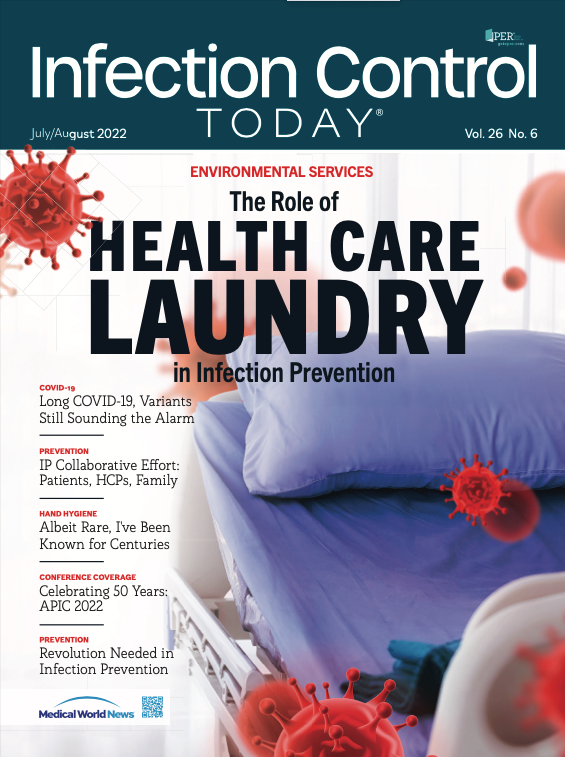Infection Prevention: A Collaborative Effort Among Patients, HCPs, and Family Members
Infection preventionists are not alone, despite how the COVID-19 pandemic has often made them feel. They are one point of the patient's triad--and the bonds within the triad are vital for the patient's outcome.
Saskia V. Popescu, PhD, MPH, MA, CIC

Infection prevention has never been a “one-person show,” even if it often feels that way. Many of us who work in infection prevention and control (IPC) look at things not only through the lens of an infection preventionist (IP), but also through those of family members, friends, and even patients. This vantage point helps us to better implement prevention efforts and to see things from perspectives that often are not incorporated into traditional IPC protocols.
Collaboration is key. It’s that simple—and yet not that simple. Full transparency requires I disclose that I’ve also been an infection patient and a relative of such patients. But as someone who utterly loves what she does, I have seen the worst and the best parts of the job, particularly during the COVID-19 outbreak. Before delving into the topic of collaboration, it’s important to address what is palpable in our community right now: fatigue and a feeling of disconnect and discontent.
After more than 2 years, the pandemic has shed light on how ill-prepared hospitals are for such events, let alone our capacity to handle the fatigue that comes with the marathon that a public health crisis entails. I also want to say what generally goes unsaid: IPs have been wildly overlooked during this pandemic. We are the first advocates for health care workers (HCWs), but we often feel that our role is seen as that of an adversary rather than an ally. IPs are the ones doing the training on personal protective equipment (PPE), translating new guidance into practice, working with families and patients, in short, implementing COVID-19 IP measures on top of our daily work.
I share this because it can be isolating to feel as though your role is ignored even though it supports the response to a global event. This sentiment and our experiences during COVID-19 will likely impact the face of IPC in the future. We’re in uncharted territory; we’re not out of the pandemic, but everyone seems to have decided it’s over. The changes in public perception and sentiment toward COVID-19 are telling in terms of how we handle health, infection prevention, and nonpharmaceutical interventions.
The Collaboration Triad
It is obvious that IPC cannot be accomplished by any one group, but too often we forget the critical nature of collaboration. There is a triad, which is made up of the health care worker, the family/support system, and IP, and the patient sits within that triad. From prevention to response to follow-up, one of IP’s most important partnerships is perhaps with the patient. Outside of rounding, I often felt that my time with patients wasn’t really the main focus of my work. The truth is that taking the time to discuss isolation status, strategies for discharge, and safety once at home can go a long way to prevent the spread of any infection. It’s very important to talk to patients about why they’re in isolation and how they can keep their loved ones safe.
IPC has a unique role to play in that we not only liaise with community-based infection prevention but also advise on alternative hospital practices. For instance, we work with patient, child life, and social services to ensure that a patient who is feeling lonely owing to isolation can video chat with family or have window-based visits and sometimes to teach the family to properly don PPE for special visits. Helping patients understand the importance of proper infection prevention habits for the invasive devices they may be discharged with is also a way to prevent both health care–associated infections and community-associated infections. Although IPC may not be directly involved in patient care, we can give them the tools to stop the spread of germs, even if it’s only by handing out masks or sanitizer. In the case of younger patients, we have a great opportunity to collaborate with their family members.
Loved Ones and Caregivers
Having relatives or caregivers on the IPC team can keep the patient safe, but that person can also serve as a good resource to remind patients or to ask important questions. Engaging with children is necessary, of course, but much pediatric care and support is achieved by interacting with their family or guardians, who are often the first to know when something is “off” with a child. Working with them to incorporate IPC strategies in the hospital—and at home—is vital. From line care to surgical wound cleanliness, and even hand hygiene, having a comprehensive approach that involves family and caregivers ensures that there is a team rallying around the patient. IPC can help discuss immunizations, at-home measures like chlorhexidine gluconate baths if needed, and infection prevention.
As Koutlakis-Barron and Hayden note, there must be awareness outside the health care setting: “Minimizing exposure to infectious organisms in the home, childcare/daycare/school settings or recreational centers will help reduce risk. Supervisory rules include the type/number of visitors with associated restrictions as applicable, preventing exposure to children with childhood illnesses being brought into the home or childcare setting. Ensuring sufficient supervision is provided by the handling of pets or animal-assisted interventions/therapy.”1 Personally, I liked rounding with pet therapy services and using that time to chat with patients and families while handing out hand sanitizer and discussing infection prevention. You’d be surprised how many people don’t realize IPC is a discipline in itself and are eager to ask us questions.
The IP-HCW Relationship
The HCW side of the triad is so essential that it feels almost comical to discuss it. Chapters could be written on the importance of their role in IPC, from perioperative care to PPE use to hand hygiene and antimicrobial stewardship. Did I mention proper cleaning and disinfection? Those are also obvious requirements, so I want to highlight another equally indispensable factor: sustainable IPC. Nearly 30 months into the pandemic, the appetite for PPE and for dealing with infectious diseases has waned. But the diseases haven’t gone away. In fact, we’re now facing the largest global spread of monkeypox ever seen, continued COVID-19 transmission alongside a diminishing interest in vaccines and nonpharmaceutical interventions, and an exhausted health care and public health workforce. So I want to spend time talking with health care workers, not at them, asking them what their concerns are and where they feel we can improve or have excelled.
Donning PPE before entering a room or waiting for a disinfectant wipe will never be the most fun thing in the world, but COVID-19 has shown us that sustaining these interventions will be our biggest hurdle. How do we get HCWs to continue caring while managing all their other work? I’ve asked them this very question. Building trust and empathetic relationships is critical for IPC-HCW collaboration and success. We depend upon them to remember the importance of infection prevention, and it’s OK to remind them of it, but without placing yet another burden on them. This is also why I like taking time to talk to patients and families, as it often lightens the health team’s duties. After all, if one side of the triad is weak or fails, the rest collapses. It takes all of us to protect patients.
Conclusions
Collaboration in this area calls for continuous work, not just interaction with teammates in health care, but also with patients and their families/support system. It is not easy, and it often requires us to adjust our communication strategies. Although communication, conflict resolution, and discussion of the science are vital components of IPC, we rarely talk about them. When considering collaboration as a means to prevent infections, we must look at every side of the triad and the bond between them. This quote by Epictetus should resonate with us all as we work to build these crucial relationships: “We have 2 ears and 1 mouth so that we listen twice as much as we speak.”
Reference:
Koutlakis-Barron I, Hayden TA. Essentials of infection prevention in the pediatric population. Int J Pediatr Adolesc Med. 2016;3(4):143-152. doi:10.1016/j.ijpam.2016.10.002
